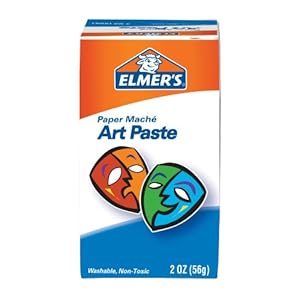I found this project on the Art for Small Hands blog (http://www.artforsmallhands.com/2009/11/papier-mache-african-face-masks.html) and adapted it to work for us. She does an amazing job explaining the entire process and I thank her for that!
We started out by looking at a variety of African masks to find a shape that worked for each student. I had cut pieces of poster board into 2" x 12" pieces and gave each child 2 pieces. They taped these together to form a circle. From there, they were able to create the shape that they wanted, whether it was a circle, oval, square, diamond, etc.
We created a grid of tape on one side of the mask and then filled the form with wadded up newspaper (the newspaper stuck to the tape, keeping it in place). Make sure that they fill their form in with newspaper- you do not want any empty spaces when you begin to papier mache.
Here is where we started to have some difficulties- my school gets really humid over the weekend (no air) and all of our masks were sitting in a warm, humid storage room. When I came back to school on Monday, I had a huge, sticky pile of poster board, newspaper and tape. They tape had come off of many of the masks! My suggestion is that before the students start filling their form with newspaper, take a stapler and staple the tape around the outside. This will help keep everything stable, especially if you live in the humid south, like I do!
 For the papier mache, I bought Elmer's Art Paste (we went through about 15 boxes of this) and mixed it up with 4 quarts of water. I put it into disposable storage containers for each table and they covered the newspaper with strips of newspaper/art paste.
For the papier mache, I bought Elmer's Art Paste (we went through about 15 boxes of this) and mixed it up with 4 quarts of water. I put it into disposable storage containers for each table and they covered the newspaper with strips of newspaper/art paste.I had them do at least 4 layers of papier mache to make sure that it would be strong enough when we took out the newspaper/tape backing.
As they worked on this, I was checking for sturdiness. Once it was strong enough, I gave them a check mark on the back. This let them know that they were ready to add a face.
 For the face, I had bins of recycled materials ready: toilet paper rolls, water bottles, plastic caps, empty boxes, poster board scraps, etc. They used these materials to add eyes, nose, mouth, horns, etc. They taped the facial features on and then had to do at least another 2 layers of papier mache.
For the face, I had bins of recycled materials ready: toilet paper rolls, water bottles, plastic caps, empty boxes, poster board scraps, etc. They used these materials to add eyes, nose, mouth, horns, etc. They taped the facial features on and then had to do at least another 2 layers of papier mache.Once everything was ready, they used their scissors to cut the tape on the back and pull out all of the wadded up newspaper, leaving the form of their mask intact.
For this part, we again looked at examples of masks and noted the colors. Most of the masks that we looked at were 1 or 2 colors and the colors were muted. I gave them the guidelines that they could use 2 colors max and that they had to create a tint or shade of the colors that they chose.
They painted their entire mask with 1 color first and then used a smaller brush to add any patterns and designs that they wanted.
I then pulled out all of my feathers, shells, Mardi Gras beads, sequins, etc and gave a lesson on glue gun safety. Then they decorated their masks, trying to stay with their color scheme in their decorations (easier for some than others- so many fun things to decorate with!)
Pin It









No comments:
Post a Comment